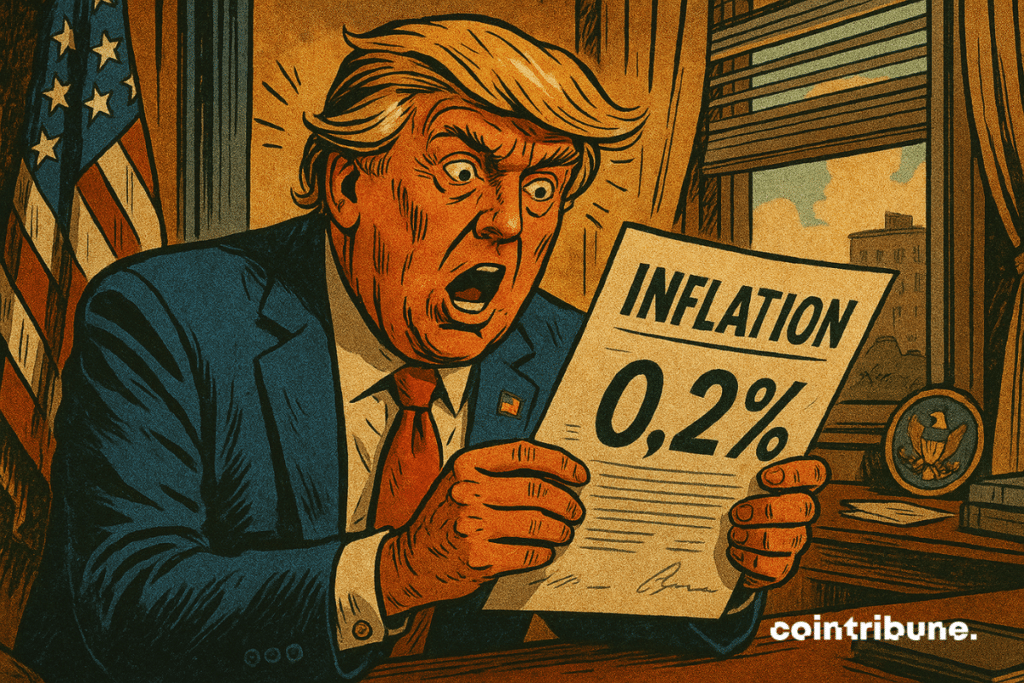21h05 ▪
4
min read ▪ by
American inflation defied all catastrophic predictions in April, dropping to 2.3% despite the implementation of massive tariffs by the Trump administration. This unexpected decline raises a troubling question: what if analysts had exaggerated the impact of protectionist measures? Could the fears of an inflationary spiral be overstated?


In brief
- Inflation fell to 2.3% in April from 2.4% in March, its lowest level since 2021.
- Trump’s tariffs have not yet produced the anticipated inflationary effect.
- Trade agreements with China and the UK could mitigate the impacts.
- Experts anticipate more pronounced effects in the coming months.
American inflation declines despite Trump tariffs
The U.S. Bureau of Labor Statistics released data on May 13 that embarrasses the doomsayers: American inflation slowed for the third consecutive month, falling from 2.4% in March to 2.3% in April.
This decrease marks the smallest increase since February 2021 and paradoxically brings the U.S. economy closer to the 2% target set by the Federal Reserve, precisely when everyone predicted otherwise.
The Consumer Price Index (CPI) rose only 0.2% in April compared to March, while economists, convinced of an immediate Trump effect, expected a 0.3% increase.
Even more surprisingly, the core CPI, which excludes volatile components like food and energy, was also limited to a 0.2% increase, defying all predictions.
However, this lull conceals contrasting sectoral trends. Food prices fell by 0.1%, a first since 2020, while energy rebounded by 0.7% after a 2.4% drop the previous month. Housing, a major component of the CPI, maintained a stable annual increase of 4%.
Delayed but inevitable effects?
Faced with these embarrassing figures, analysts are looking for explanations to save their alarming forecasts.
In early April, the U.S. president had indeed set a benchmark rate of 10% on most imports, with duties of 145% on Chinese products and 25% on automobiles, steel, and aluminum.
BeiChen Lin, senior strategist at Russell Investments, tries to justify the discrepancy:
Businesses likely built up inventories before the tariffs took effect, delaying their impact on inflation.
A convenient excuse echoed by UBS, which now pushes its catastrophic predictions to between May and October.
In the meantime, trade negotiations are progressing. An agreement with China provides for a mutual reduction of tariffs by 115 points for 90 days, while an arrangement with the United Kingdom exempts certain strategic sectors, suggesting a more nuanced approach than the foretold apocalypse.
JPMorgan also sounded the alarm, raising the probability of a global recession to 60%. The bank estimates these protectionist measures will cost American consumers $700 billion, equivalent to 2.4% of GDP.
The American economy seems to resist the darkest predictions: inflation slowing against all odds and tariffs whose apocalyptic effects are still awaited.
This lull may only be temporary, leaving markets anticipating the next decisions of the Fed and the evolution of international trade negotiations. Only the coming months will reveal whether this resilience endures or if the delayed impacts finally materialize.
Maximize your Cointribune experience with our “Read to Earn” program! For every article you read, earn points and access exclusive rewards. Sign up now and start earning benefits.
Passionné par le Bitcoin, j’aime explorer les méandres de la blockchain et des cryptos et je partage mes découvertes avec la communauté. Mon rêve est de vivre dans un monde où la vie privée et la liberté financière sont garanties pour tous, et je crois fermement que Bitcoin est l’outil qui peut rendre cela possible.
DISCLAIMER
The views, thoughts, and opinions expressed in this article belong solely to the author, and should not be taken as investment advice. Do your own research before taking any investment decisions.

